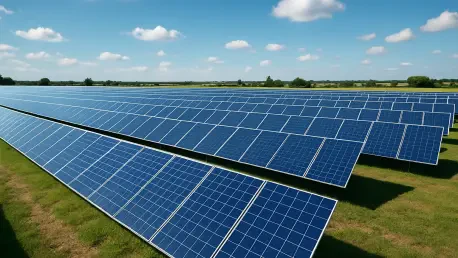In the quaint town of Woodstock, near Oxford, stands St Mary Magdalene’s Church, a Grade II* listed building steeped in centuries of history and architectural splendor, nestled within a conservation area and bordering a World Heritage Site. This church is more than a place of worship; it’s a cultural treasure that embodies the past, yet as the world grapples with the urgent need to combat climate change, a groundbreaking decision has been made to install solar panels on its ancient roof. Approved by the Consistory Court, this move raises a profound question about whether historic structures can embrace modern sustainability without losing their timeless essence. The case of St Mary Magdalene’s offers a compelling lens through which to explore the delicate balance between preserving heritage and addressing contemporary environmental and financial challenges, setting a potential precedent for religious institutions across the globe.
Environmental and Financial Imperatives
Balancing Green Goals with Economic Needs
The drive to install solar panels on St Mary Magdalene’s Church is deeply rooted in a commitment to environmental sustainability, aligning with the Church of England’s ambitious target of achieving Net Zero carbon emissions. This initiative is projected to reduce carbon dioxide emissions by an amount equivalent to the absorption capacity of over 170 trees each year. Moreover, the panels will generate a substantial portion of the church’s energy needs, cutting reliance on fossil fuels by more than half. This significant step not only supports diocesan goals but also positions the church as a beacon of ecological responsibility within the community. As climate concerns intensify, such actions by religious institutions highlight a growing recognition of their role in fostering a greener future, proving that even the most traditional spaces can adapt to pressing global demands without forsaking their core identity.
Financial sustainability is another critical factor behind the decision to adopt solar technology at this historic site. Maintaining a Grade II* listed building is a costly endeavor, with operational expenses often straining parish budgets, a challenge worsened by economic downturns like those experienced during the COVID-19 pandemic. The solar installation is expected to yield considerable annual savings on energy bills, providing much-needed relief to the church’s finances. Additionally, surplus energy sold back to the grid could create a modest revenue stream. While the Diocesan Chancellor, Judge David Hodge KC, cautioned that financial gain should not be the sole motivator, the economic benefits are undeniable, offering a practical solution to ensure the church’s long-term viability. This balance of environmental and fiscal priorities demonstrates a pragmatic approach to sustaining both mission and heritage in challenging times.
Weighing Costs Against Ecological Gains
Delving deeper into the economic rationale, the projected savings from the solar panel installation are not just immediate but also forward-looking, with estimates suggesting a steady reduction in energy costs over the coming years. From now until late 2026, the church anticipates savings of several thousand pounds annually, even under conservative electricity pricing models. This financial cushion is vital for a parish struggling to meet its share of diocesan contributions amidst rising operational expenses. Beyond direct savings, the potential income from excess power generation adds another layer of economic stability. However, the Chancellor’s ruling underscores that such monetary benefits must be secondary to a genuine commitment to energy efficiency, ensuring that the project’s primary focus remains on reducing environmental impact rather than merely boosting the church’s coffers.
The environmental gains, while quantifiable, carry a broader significance that transcends numbers. The reduction in fossil fuel dependency aligns with a moral imperative felt by many religious communities to act as stewards of the planet. By adopting renewable energy, St Mary Magdalene’s not only cuts its carbon footprint but also contributes to a cultural shift within ecclesiastical circles, where sustainability is increasingly seen as a spiritual duty. This initiative reflects a nuanced understanding that ecological responsibility can enhance, rather than detract from, the church’s mission. As other historic buildings observe this model, the ripple effect could encourage wider adoption of green technologies, proving that even small-scale projects can have a profound impact on collective climate action within heritage contexts.
Heritage Preservation and Aesthetic Considerations
Minimizing Impact on Historic Integrity
When considering alterations to a Grade II* listed building like St Mary Magdalene’s Church, the preservation of historical and aesthetic integrity is of utmost importance. The solar panel installation has been meticulously planned to ensure minimal visual disruption, with the panels positioned on the south nave and aisle roofs, areas less visible from primary viewpoints. From the southern churchyard, the impact is slight at best, and the associated cabling is designed to blend seamlessly with existing infrastructure. Heritage bodies, including Historic England, reviewed the proposal and raised no significant concerns, affirming that the church’s cultural and architectural significance remains unharmed. This careful approach illustrates that modern sustainability solutions can be integrated into historic structures with sensitivity, maintaining their storied charm while meeting contemporary needs.
Further examination of the project reveals a deliberate effort to prioritize heritage over innovation where conflicts might arise. The decision to limit the visibility of the solar panels reflects a broader principle of non-intrusive adaptation, ensuring that the church’s iconic silhouette and historical fabric are not compromised. This balance was achieved through close consultation with experts who specialize in preserving listed buildings, demonstrating a collaborative spirit between parish leaders and conservation authorities. Their consensus highlights a growing acceptance that renewable energy projects need not be at odds with heritage goals. Instead, such initiatives can coexist harmoniously if guided by rigorous planning and a commitment to minimizing aesthetic impact, offering a model for other historic sites facing similar dilemmas in the push toward sustainability.
Safeguarding Cultural Significance
The cultural weight of a building like St Mary Magdalene’s cannot be overstated, as it serves as a tangible link to centuries of community life and architectural evolution. Protecting this legacy required a design that respects the church’s historical narrative, ensuring that any modern additions do not overshadow its past. The solar panels, while functional, were chosen and placed with an eye toward subtlety, avoiding any alteration that might detract from the building’s status as a Grade II* listed site. This respect for history extends beyond mere appearance to encompass the church’s role as a cultural anchor, where changes must be weighed against their potential to alter public perception of its heritage value. The approval process reflects a meticulous effort to honor this dual responsibility to past and future.
Equally important is the precedent this project sets for integrating technology without sacrificing cultural essence. The minimal impact on the church’s appearance reassures stakeholders that heritage preservation need not halt progress toward sustainability. By demonstrating that solar installations can be discreet yet effective, St Mary Magdalene’s challenges the notion that historic buildings must remain untouched to retain their significance. This case suggests that with thoughtful design and expert input, other churches and heritage sites can adopt similar measures, bridging the gap between maintaining historical reverence and embracing necessary environmental advancements. It’s a testament to the potential for innovation to enhance rather than diminish the value of cultural landmarks.
Community Leadership and Symbolic Impact
Inspiring Through Visible Action
Beyond the practical benefits of energy savings and carbon reduction, the solar panel installation at St Mary Magdalene’s Church carries a profound symbolic weight for the surrounding community. The parish views this project as a public declaration of environmental stewardship, embodying a commitment to safeguarding “God’s environment” in a visible, tangible way. Positioned near Woodstock and the iconic Blenheim Palace, the church draws both locals and visitors who may be inspired by this subtle yet meaningful gesture. The panels signal a dedication to addressing the climate emergency, aligning with diocesan values and broader societal shifts toward sustainability. This act of leadership underscores the potential for historic institutions to influence public attitudes, showing that even sacred spaces can champion modern causes without losing their traditional resonance.
The ripple effect of such a visible commitment extends beyond immediate surroundings, fostering dialogue about the role of religious institutions in environmental advocacy. By taking a proactive stance, St Mary Magdalene’s positions itself as a model for other parishes within the diocese and beyond, encouraging them to consider how they might contribute to climate goals. This symbolic impact is amplified by the church’s location in a conservation area, where its actions are under public scrutiny, offering a unique opportunity to demonstrate that heritage and innovation are not mutually exclusive. The project serves as a quiet reminder that small, thoughtful changes in historic settings can inspire larger movements, galvanizing communities to prioritize sustainability as part of their shared values and responsibilities.
Setting a Precedent for Broader Change
Reflecting on the broader implications, the decision to equip St Mary Magdalene’s with solar panels sets a powerful example for historic churches grappling with similar challenges. The approval by the Consistory Court, grounded in a balance of environmental urgency and heritage sensitivity, provides a framework for future projects across the Church of England. It suggests that with careful planning, religious institutions can lead by example, showing that adaptation to climate priorities is both feasible and necessary. This precedent could encourage hesitant parishes to explore renewable energy options, knowing that such initiatives can be executed without compromising historical value. The ruling also emphasizes that genuine environmental commitment must underpin these efforts, ensuring they are not driven solely by financial incentives.
Looking back, the successful integration of solar technology at St Mary Magdalene’s Church marked a pivotal moment in redefining how historic buildings adapt to modern demands. The minimal visual impact, coupled with significant ecological and economic benefits, illustrated a path forward for others to follow. This project highlighted the importance of collaboration between heritage experts, parish leaders, and diocesan authorities in achieving a harmonious outcome. As a result, it paved the way for future considerations, encouraging historic sites to explore innovative solutions while preserving their cultural legacy. The lasting lesson was clear: with thoughtful execution, religious institutions could champion sustainability, inspiring communities to embrace change while honoring the past.









